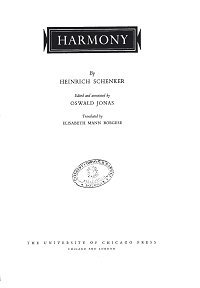|
Schenker Heinrich - Harmony |
Schenker Heinrich - Harmony
Schenker Heinrich - Harmony. You can download the PDF sheet music Schenker Heinrich - Harmony on this page. Heinrich Schenker published his Harmony anonymously in 1906, under the most unusual title, "New Musical Theories and Fantasies—by an Artist." The title itself was to indicate the author's intention of finding artistic solutions to artistic problems rather than any concern for commonplace theoretical discussions. This volume was the first in a long series and marks the beginning of a lifelong development, which was concluded only with the last volume, Free Composition, published thirty years later—a few months after the author's death. In this sequence of works, interspersed with a good number of other publications, Schenker revealed his theories as they developed. Each volume represents a step forward, based on an ever growing artistic experience. This process, however, entailed certain difficulties. Some concepts were still immature when first published and found their final and clear expression only in a subsequent volume. Furthermore, certain parts of the work, though each one of them constituted an essential basis for subsequent constructions, would, in certain aspects, be obsolete when the later work appeared.
The core of music theory as it had developed and was taught in the eighteenth century was voice-leading. The study of theory was divided into two parts: the study of strict counterpoint and the study of figured bass ("thorough bass" or "continuo"). The rules guiding the former were derived from the epoch of vocal music. They were codified by Joseph Fux in Gradus ad Parnassum (recently reprinted in part in an English translation). In this work Fux undertook an analysis of the nature of intervals, a distinction between consonant and dissonant notes, and a study of the use of the latter. It was a study of voice-leading in its purest form, totally free of any considerations of harmony. More than anything else, it was a body of rules for the training of the ear. In this sense counterpoint has attained universal validity. But it never could lay claim to the teaching of advanced composition, although this may have been the original intention of Gradus ad Parnassum; in this respect Fux was still too deeply under the influence of the vocal epoch.
To download PDF, click the "Download PDF" button below the appropriate sheet music image.
To view the first page of Schenker Heinrich - Harmony click the music sheet image. |
| PDF format sheet music |
|
|
|
Book: 391 pages. 72390 K
|
|
 |
|
|
|
| Download PDF (14.99
€) |
|
|
|
In the long run, however, neither hostile attacks nor silence could subdue the need for a more objective grappling with the problems. This was true with regard to Schenker's work, as it is true with regard to any important intellectual movement. And at no time has there been a more urgent need for a basic reorientation than just now. We are passing through a period admittedly submerged in experiments, with all basic concepts thrown into a state of hopeless confusion. There are many who, consciously or unconsciously, have set out to find a solution; who arc groping for a clarification of the basic problems of art, a clarification which is essential for an understanding of the fundamentals of music as art. Of course, there are also those who still try to escape reality and to circumvent the answers. There are also those who know Schenker's theories only from secondhand sources, which are responsible for a number of misunderstandings.
Both categories of musicians may be skeptical with regard to Schenker's work, and they will ask whether and why Schenker should be considered the man to bring the needed clarification. It is up to the writer of this Introduction to give a convincing affirmative answer to these questions in the following pages. It is legitimate, however, to quote here an opinion whose complete impartiality must be beyond any suspicion. In December, 1936, when Schenker's name and work were blacklisted for political reasons, an article appeared in the Allgetneine Musik Zeitung under the title, "Can We Still Listen to Music?" Whether the author, Hans Jenkner, proceeded from defiance or unawareness of the circumstances is beyond my judgment. Whatever his motives, he deserves to be rescued from oblivion. |
|